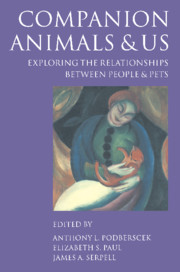Book contents
13 - The meaning of companion animals: qualitative analysis of the life histories of elderly cat and dog owners
from Part III - Pets, families and interactions
Summary
INTRODUCTION
The human–animal bond has a long history. The first evidence of a probable domestic dog was found in a Palaeolithic grave at Oberkassel in Germany, dated at 14 000 years BP (before present). The first evidence of a special bond between humans and animals was found at the site of Ein Mallaha (Israel), where a grave from 12000 years BP was found. In it, a human was buried together with a puppy (Clutton-Brock, 1995). From cave paintings, ancient pictures, statues, excavations and literature, we know that animals played diverse and important roles in the lives of our ancestors. They played various religious roles, were ‘used’ as hunters, guardians, or were just companions.
Today, the roles that domestic animals such as cats and dogs play are just as diverse and depend on the cultural contexts in which they find themselves. In the West they are considered as companion and ‘working’ animals (e.g. dogs assisting people with disabilities, guarding flocks of sheep, protecting homes from burglary, assisting police and customs officers). In some other cultures, dogs are considered as food, as ‘impure’ or as ‘outcasts’ (Serpell, 1995).
THE PET AS LOVE OBJECT, FRIEND, ATTACHMENT FIGURE, NETWORK MEMBER
In the last three decades, researchers from different disciplines have focused on the human–animal bond, accentuating interactions and attitudes of humans towards pets, or emphasizing the consequences of this relationship for the physical and/or the mental well-being of the owners. For example, Levinson (1969) argued from within a psycho-analytic framework that pets satisfy vital emotional needs among the elderly by providing a love object. Pets can serve as primitive defence mechanisms, as ‘objects of identification’, and as ‘counterbalances’ in situations in which the elderly suffer from the loss of relatives, friends and associates; where they become physically dependent on others; and in the process of accepting oneself as an elderly person. Furthermore, Levinson (1969) stated that pets could pave the way to new friendships and may give the elderly a reason for living. Rynearson (1978) observed that the bond between humans and pets is based on their communality as animals and their mutual need for attachment. He focused on ‘pathological attachment relationships’ in which relationships between humans and pets served a defensive purpose and disruption of the bond could create enduring psychiatric problems:
Under normal circumstances they share complementary attachment because of mutual need and response.
- Type
- Chapter
- Information
- Companion Animals and UsExploring the relationships between people and pets, pp. 237 - 256Publisher: Cambridge University PressPrint publication year: 2000



